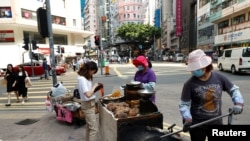In many Asian countries, street food has long been an important part of society and the economy. The offerings are tasty and do not cost very much.
But the COVID-19 pandemic and now the war in Ukraine are putting pressure on the food traditions.
In Beijing, China, profits at Ma Hong's hotpot restaurant have been cut by about 20 percent since it opened last year. The prices of beef have shot up by more than 50 percent. The costs of other important food products are rising, too.
Ma said, "We sell it at the same price as before. Also, with the impact of the pandemic, everybody is hanging in there. It is the same all over Beijing, we are not the only restaurant suffering."
Asian restaurants and street food sellers are facing a difficult choice. They can keep the same price and lose money or raise the cost of food and lose customers.
The prices of goods that were limited in supply during the pandemic are now even higher because of Russia’s war in Ukraine.
Mohammad Ilyas is a cook at a biryani shop in Karachi, Pakistan. He said the price of a kilogram of biryani, a seasoned rice dish, has doubled in price. It now costs about 400 Pakistani rupees, or $2.20.
"I have been working at this kitchen for the last 15 years," he said. "These days prices of rice and spices have gone up so much that poor people can't afford to eat..."
Some businesses are dealing with the cost pressures by giving customers smaller food servings.
At a street food corner in Jakarta, Indonesia, Syahrul Zainullah has cut his servings of an Indonesian fried rice dish. He chose to do this instead of raise prices or use lower quality ingredients.
In South Korea, inflation at a 12-year high. Choi Sun-hwa, a kimchi shop owner, explained that the cost of cabbage has risen greatly. Kimchi is traditionally served for free alongside meals at Korean eateries. But even kimchi has become a costly food product. Choi said she will not be able to continue to operate her shop if she cannot raise her prices.
Seo Jae-eun, a customer at Choi's shop, said kimchi should now be called "keum-chi.” Keum means “gold” in Korean.
"I can't ask restaurants to give more kimchi these days,” she said. “And it's too expensive to make my own at home.”
The price pressures are changing the ways that some Asians eat.
Steven Chang is a regular at Just Noodles, a popular ramen store in Taipei, Taiwan. The 24-year-old is now reconsidering his spending.
"I live away from my parents, so I rely on restaurant food a bit more," Chang said. "So, I will try to limit eating out and cook at home more."
I’m Ashley Thompson.
The Reuters news agency reported this story. Hai Do adapted it for VOA Learning English.
_____________________________________________________________
Words in This Story
society - n. people in general thought of as living together in organized communities with shared laws, traditions, and values
impact - n. a powerful or major influence or effect
customer - n. someone who buys goods or services from a business
ingredient - n. one of the things that are used to make a food, product, etc.
rely - v. to need (someone or something) for support, help, etc. : to depend on (someone or something)









